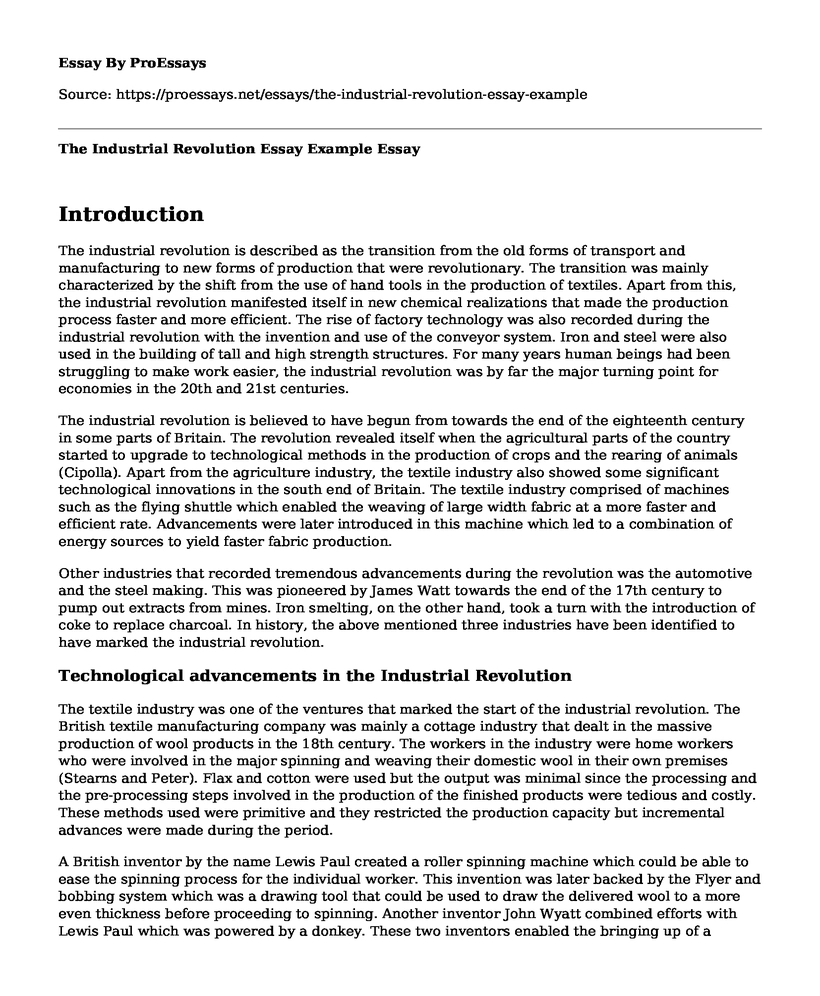Introduction
The industrial revolution is described as the transition from the old forms of transport and manufacturing to new forms of production that were revolutionary. The transition was mainly characterized by the shift from the use of hand tools in the production of textiles. Apart from this, the industrial revolution manifested itself in new chemical realizations that made the production process faster and more efficient. The rise of factory technology was also recorded during the industrial revolution with the invention and use of the conveyor system. Iron and steel were also used in the building of tall and high strength structures. For many years human beings had been struggling to make work easier, the industrial revolution was by far the major turning point for economies in the 20th and 21st centuries.
The industrial revolution is believed to have begun from towards the end of the eighteenth century in some parts of Britain. The revolution revealed itself when the agricultural parts of the country started to upgrade to technological methods in the production of crops and the rearing of animals (Cipolla). Apart from the agriculture industry, the textile industry also showed some significant technological innovations in the south end of Britain. The textile industry comprised of machines such as the flying shuttle which enabled the weaving of large width fabric at a more faster and efficient rate. Advancements were later introduced in this machine which led to a combination of energy sources to yield faster fabric production.
Other industries that recorded tremendous advancements during the revolution was the automotive and the steel making. This was pioneered by James Watt towards the end of the 17th century to pump out extracts from mines. Iron smelting, on the other hand, took a turn with the introduction of coke to replace charcoal. In history, the above mentioned three industries have been identified to have marked the industrial revolution.
Technological advancements in the Industrial Revolution
The textile industry was one of the ventures that marked the start of the industrial revolution. The British textile manufacturing company was mainly a cottage industry that dealt in the massive production of wool products in the 18th century. The workers in the industry were home workers who were involved in the major spinning and weaving their domestic wool in their own premises (Stearns and Peter). Flax and cotton were used but the output was minimal since the processing and the pre-processing steps involved in the production of the finished products were tedious and costly. These methods used were primitive and they restricted the production capacity but incremental advances were made during the period.
A British inventor by the name Lewis Paul created a roller spinning machine which could be able to ease the spinning process for the individual worker. This invention was later backed by the Flyer and bobbing system which was a drawing tool that could be used to draw the delivered wool to a more even thickness before proceeding to spinning. Another inventor John Wyatt combined efforts with Lewis Paul which was powered by a donkey. These two inventors enabled the bringing up of a factory with close to fifty donkey spindles that combined further processes such as carding, twisting and rolling which massively increased the output per worker. The production of cotton was then on the rise with people gaining employment in the factories hence increased economic development. These events have been documented to have taken place between the years of 1743 and 1748 (Stearns and Peter).
Furthermore, an entrepreneur Richard Arkwright who was also an inventor made advances in the production and processing of cotton. Arkwright nurtured and developed the ideas and innovations of other inventors. He was also responsible for protecting inventors in the textile industry since their inventions were prone to vandalism by other malicious citizens who were being rendered unemployed due to the invention of innovative technology. Apart from this Arkwright also patented ideas and financed initiatives and protected the machines and built a factory that brought the textile inventions together leading to the development of the world's largest cotton production in Britain which was formerly in India. The shift from donkey power to horse power in the factory was developed and later the use of hydropower. All these contributions in the textile industry by the inventions and creations assisted in the laying of a suitable foundation in the industry to date as the machined which were formerly used have been automated but the principles of operation remain the same.
Conclusion
Power sources and the use of steam power also assisted in fueling the revolution from the use of animal power and man power. Improvements of the steam engine were the most important in the industrial revolution which can be accrued to the Scottish inventor James Watt in mining and the pumping of water to greater heights. The motive for the development of steam power at the time was to replace hydropower but it later served other purposes such as transportation.
Works Cited
Cipolla, Carlo M., ed. The industrial revolution. Vol. 3. Collins, 1973.
Stearns, Peter N. The industrial revolution in world history. Routledge, 2018.
Cite this page
The Industrial Revolution Essay Example. (2022, Oct 23). Retrieved from https://proessays.net/essays/the-industrial-revolution-essay-example
If you are the original author of this essay and no longer wish to have it published on the ProEssays website, please click below to request its removal:
- Lessons From Watchman Nee Essaya
- Wolfgang Amadeus Mozart Paper Example
- The Influence of the United States Supreme Court on the Social, Political, and Economic History
- Essay Example on Soldiers' Sacrifices for Patriotism: Exploring War and Violence in Iraq
- Colonial Slave Labor: Issues and Implications - Essay Sample
- California's Quest for Freedom: Opposing the Fugitive Act in 1851 - Essay Sample
- Free Paper Sample on Protestant Reformation: Foundation of Protestantism & Far-Reaching Impacts







